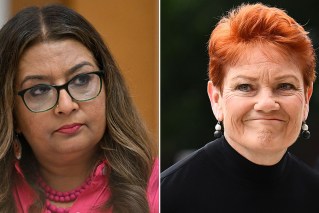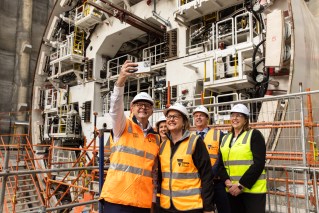Michael Pascoe: Tweaks won’t fix housing crisis while half of Australia suffers

Nothing demonstrates the myopia of Australian political leadership better than the way the national housing crisis apparently happened overnight.
Suddenly we have a shortage of housing – who could have known?
Suddenly affordable and social housing is no longer available – was that some sort of black magic trick?
Suddenly the ratio of the cost of housing to household income is sky high – where did that come from?
Suddenly there are multiple roundtables and promises of government subsidies – can anyone see in what direction the horse bolted and how long has the gate been missing?
Suddenly there are myriad forecasts that the housing catastrophe will only get worse in coming years, even with the aforementioned roundtables. And if the promised subsidies come to pass – can we have another roundtable?
This disaster has been decades in the making as governments wilfully let public and affordable housing stagnate, and with the bipartisan policy of leaving the provision of sustainable, secure housing to “the market”, prioritising the development of a solid landlord voting bloc.
No rapid or easy fix
Plenty of people did see the crisis building, but the politics of home ownership and real estate investment meant no government wanted to know until it was too late to head it off.
The result is that there is no rapid solution and certainly no easy one.
The various state and federal announcements are but Band-Aids – nobody has the stomach for the necessary surgery to attempt an actual cure.
There are various painkillers, tinctures, prayers and prescriptions being offered to try to lessen various symptoms of the underlying problem.
The Reserve Bank, for example, is maintaining its faith in Dr Market, basically believing the high cost of renting and buying will force people back into the share houses many wanted to escape during COVID lockdowns and the WFH (working from home) epidemic.
Yes, the way Philip Lowe told it to the National Press Club, he’s banking on the kids moving back in with Mum and Dad and the return to dying with a falafel in your hand.
Colleague Kohler this week suggested long term rents need to rise to narrow the premium Airbnb rentals achieve and then the National Rental Affordability Scheme needs to be revived and expanded to help those who can’t afford the higher rents.
My own offering is less landlord-friendly: Rental property interest and other costs should only be deductible for the period a property is actually rented, not just “available” for rent.
Thus a landlord with an Airbnb property that tended to be rented only three days a week could only claim 43 per cent of his or her interest, maintenance, agent and cleaning costs. That would narrow the premium as well as improving government revenue.
Ditto with standard holiday rental properties – places that are booked out in school holidays but otherwise largely empty could become more likely to move to permanent rentals.

Max Chandler-Mather of the Greens opposed the building of over 1000 homes in his electorate. Photo: AAP
NIMBYs rule
NSW’s new Labor Housing Minister, Rose Jackson, has 52,000 people on her social housing waiting list across the state. She told The Guardian part of her solution for Sydney is to rapidly build medium and high-density social housing developments on the city’s North Shore and eastern suburbs with a new agency, Homes NSW, setting more ambitious targets for social housing and refurbishments.
That the NIMBYs of the North Shore and eastern suburbs don’t vote Labor is coincidental.
Meanwhile, the Greens’ federal housing spokesman, Max Chandler-Mather, somehow seems to think he can help renters by opposing the building of 1,300 new homes in his Brisbane electorate of Griffith, the AFR has reported.
The Greens are big on the need for more social housing, wanting extremely ambitious spending by the Commonwealth, but as the legendary US politician Tip O’Neill famously said, all politics is local. NIMBYs rule.
Check the comments section under stories such as this on the housing crisis and there will be other suggestions, the most common being reducing migration at a time when we need to import skills and our universities are again digging into their international students for money.
Commenter “Citizen” on these pages made a reasonable point about the hundreds of thousands of students “who want low-cost housing while they study and who absorb the supply of affordable properties, displacing people who already live here”.
“Compel the universities who have international students to build purpose-built student accommodation, on their own land, at their own cost,” Citizen advised.
“The universities have massive land holdings, look at Melbourne University, it takes up half of Carlton, look at Latrobe in Bundoora or Monash in Clayton, both massive land holdings.”
There are plenty of horror stories about international student accommodation at present, stories that do our education industry no favours. The accommodation could become another income stream for the institutions.
Such is the extent of the crisis, we need all the incremental help we can get.
Meanwhile, the underlying problem of near-criminal housing policy becomes more baked-in by the explosion of inequality in Australia.
The rich get richer
According to the Australia Institute, the bottom 90 per cent of Australians received just 7 per cent of economic growth per person since 2009 while the top 10 per cent reaped 93 per cent of the benefits.
And the combination of the RBA’s drive to contain inflation with the housing shortage means nearly half of Australia is carrying the pain for the rest.
In rough numbers, about a third of Australians rent, a third have a mortgage and a third own their home outright.
The RBA and anyone with eyes can see that the third who rent – nearly all of them from private landlords – are the ones who are suffering most now, will continue to do so for years and are least able to handle it.
Then there are the third of borrowers who will have their spare cash reduced by at least 40 per cent as the full impact of a 3.5 per cent cash rate rolls through the system and another 20 per cent of borrowers who will have their disposable income cut by between 20 and 40 per cent.
That’s the reality of our housing policy legacy colliding with the RBA’s blunt instrument.
What a surprise.








